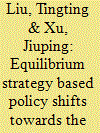|
|
|
Sort Order |
|
|
|
Items / Page
|
|
|
|
|
|
|
| Srl | Item |
| 1 |
ID:
177140


|
|
|
|
|
| Summary/Abstract |
As coalbed methane, the natural gas adsorbed in coal seams, is a greenhouse gas that is 21 times stronger than CO2, coalbed methane extraction significantly influences carbon reduction and energy conservation efforts. While the injection of CO2 into coal seams is known to effectively enhance coalbed methane recovery, this process has been limited because of high investment and production costs. Therefore, to promote the application of CO2 injection techniques in coalbed methane industry, this paper proposes an authority–enterprise equilibrium based mixed subsidy mechanism which combines direct subsidies with indirect tax-incentives. Specifically, a multi-objective bi-level programming model is established under uncertainty to assign a practical constraint and achieve a trade-off between the local authority and the coalbed methane plants. A practical case validates the feasibility and efficiency of the proposed method, proving that an authority–enterprise equilibrium based mixed subsidy mechanism is able to achieve carbon emissions reductions and conserve energy. Further analysis indicated that the marginal energy efficiency gains were greater than the authority costs under a strict energy utilization policy and that the environmental protection target had larger impacts on the coalbed methane plant performances.
|
|
|
|
|
|
|
|
|
|
|
|
|
|
|
|
| 2 |
ID:
162318


|
|
|
|
|
| Summary/Abstract |
Carbon emissions are posing continuing threats to climate change and becoming the important evaluation indicator for sustainable development. The amount of global carbon emission is increasing largely, with coal-fired power plants (CPP) being the major contributor. This study proposes dynamic equilibrium strategy based on biomass-coal co-firing method to reduce carbon emissions, in which bi-level programming method is employed to build a cooperative relationship between the authority and CPPs, dynamic programming method is used to handle biomass availability time conflict, multi-objective programming method is applied to seek the trade-off between economic development and environmental protection, and furthermore uncertainty theory is introduced to address imprecise uncertain parameters. The proposed model is then applied to a case in Jiangsu, China, to demonstrate its efficiency and practicality, and an interactive algorithm is developed as the solution approach to represent the objectives and limitations between several stakeholders. Based on analyses and discussions under different scenarios, the proposed method can achieve economic-environmental coordination and realize sustainable development, and moreover a carbon emissions allocation competition mechanism is recommended. This methodology could be used in various countries and industries with only slight adjustments needed to some parameters.
|
|
|
|
|
|
|
|
|
|
|
|
|
|
|
|
| 3 |
ID:
180164


|
|
|
|
|
| Summary/Abstract |
As part of China's power industry reforms, developing appropriate market designs for the inclusion of renewable energy in the electricity spot market has been an ongoing challenge. This paper examined the effects of different market rules on wind power producer behavior to identify the policy implications for a renewable-friendly spot market, for which a market equilibrium model was developed to assess power transactions in the day-ahead and balancing markets, with the upper level being wind power producers seeking the best profits, and the lower level being the market clearing process to minimize generation costs. A case study is given, in which different scenarios are explored to assess the effects of bidding regulations and imbalance pricing mechanisms and to simulate the rising wind penetration in power systems. It was found that in the region modeled: more relaxed bidding regulations could provide wind producers incentives by allowing more profitable strategies; the imbalance pricing settings influence market results and producer revenues; and lower spot prices and power generation costs occur if a larger wind share was fed into the power system and could result in a unit revenue decline. Therefore, new policy directions are needed for the development of China's renewable-friendly electricity markets.
|
|
|
|
|
|
|
|
|
|
|
|
|
|
|
|
| 4 |
ID:
185699


|
|
|
|
|
| Summary/Abstract |
Renewable portfolio standards have been found to be effective in promoting renewable energy developments; however, in China, the implementation of renewable portfolio standards is not yet fully developed. Based on policy acceptance, generation costs, and renewable power target perspectives, this paper proposes a multi-objective equilibrium model to develop an annual single province power plan. A case study from Guangdong province, China, is presented to demonstrate the practicality and efficiency of the presented model. Comparison analysis with current plans are made, three scenarios which consider the non-hydro renewable targets, market competition and a tougher environmental attitude are designed to adapted to the decision maker's preferences. It was found that: (1) the optimal model reallocated policy costs between power users, distributed the generation capacity between provinces, and could obtain 35.4% renewable electricity and 4.3% of non-hydro renewable electricity consumption in Guangdong; and (2) compared with the current plan, the optimal model effectively maintained power tariffs, decreased generation costs by 2.42%, and decreased Guangdong's electricity generation CO2 emissions by 8.21%. Policy suggestions for provincial governments to better implement provincial renewable portfolio standards are given.
|
|
|
|
|
|
|
|
|
|
|
|
|
|
|
|
| 5 |
ID:
107509


|
|
|
|
|
| Publication |
2011.
|
| Summary/Abstract |
The national goal of 40-45% mitigation of the 2005 level intensity of carbon by 2020 was announced by the Chinese government at the Copenhagen Conference. Every industry in China is preparing to realize this national reduction target. Some attempts have been made to achieve low-carbon development in a few industries, but relatively little work has linked low-carbon development to tourism. This article concentrates on how to develop low-carbon tourism using a quantitative approach. Firstly, the tourism system including some mutual influence factors is investigated and some historical data are given in support for the research of their quantitative relationship. Secondly, a differential dynamic system model with fuzzy coefficients is proposed to predict tourism revenue, energy consumption, waste emissions and the carbon intensity. Finally, an application to Shizhong District of Leshan City in China (LCSD), as a representative of a world natural and cultural heritage area, is presented to show the trend of modern tourism in a low-carbon economy and prove the effectiveness of the proposed model.
|
|
|
|
|
|
|
|
|
|
|
|
|
|
|
|
| 6 |
ID:
176820


|
|
|
|
|
| Summary/Abstract |
Wind energy has gained significant support to be one of the primary sources of near-zero-emission energy systems. Based on the technological paradigm theory and employing a novel data analysis system (DAS), this paper provides an overview of wind energy technological developments. With key energy law and policy decisions highlighted, the visualization process clearly identified the three technological paradigmatic stages; competition, diffusion and shift; from which it is found that wind-based hybrid energy systems appear to give better promising trajectory in the future than wind energy technologies that rely only on onshore or offshore winds. However, with market maturation, the challenges associated with increasing share, energy storage, motivational conflicts, demand responses and optimal scheduling emerge and are expected to be resolved. From the paradigm shift investigation, a comprehensive sustainable framework for a six-stage hybrid wind-photovoltaic energy system is proposed. Recommendations on policy shifts to encourage technological innovation, regional differentiation, improve monitoring & evaluation systems and the implementation of smart grid are also given to address the incentives that need to be provided.
|
|
|
|
|
|
|
|
|
|
|
|
|
|
|
|
|
|
|
|
|